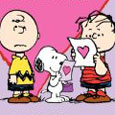Studio Ghibli (July 17, 1999), Walt Disney Home Entertainment (August 16, 2005), single disc, 104 mins plus supplements, 1.85:1 anamorphic widescreen, Dolby Digital 5.1, Rated PG, Retail: $29.99
Storyboard:
Many aspects of Japanese family life are presented in a series of vignettes.
The Sweatbox Review:
Up until now, the Studio Ghibli releases seen in Region 1 have been either environmental fables or whimsical fantasies, generally done in a relatively realistic and sumptuous style. So, it was with great interest that I took on the task of reviewing a very different type of Ghibli film, My Neighbors The Yamadas, Isao Takahata’s 1999 writing and directorial effort. This was a large departure for the studio in many ways, as well as a huge departure from Takahata’s own Grave Of The Fireflies and Pom Poko. The most obvious difference between this film and other Ghibli pieces is the style of artwork, and the other is the subject matter. Unfortunately, as excited as I was to sample My Neighbors The Yamadas, I was left with the impression that the studio should stick to eco-princesses and stories of magical transformations.
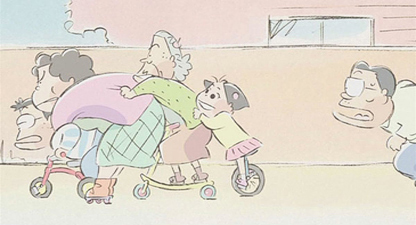
I really hate to say that, too, because I normally embrace diversity and really wanted to like this film; but sometimes things just don’t work out. I am aware that this film has its admirers. A sticker on the DVD’s slipcover has a quote from Brad Bird praising the film, and goodness knows that I love Bird’s own work, but Yamadas was just not my cup of saki.
My Neighbors The Yamadas certainly appeared to me to have the makings of a charming film. The Yamadas are a typical Japanese family consisting of hard-working dad Takashi, his housekeeping-challenged wife Matsuko, disapproving son Noboru, noisy daughter Nonoko, and a blunt-speaking grandmother named Shige. In sitcom style, the film shows their interaction with one another as they take on life’s various challenges. The Yamadas actually come from a comic strip by Hisaichi Ischii (called Tonari No Yamada-kun), and you can tell that an attempt was made to recreate or at least emulate moments from the strip. The film is really a series of vignettes, similar to many of the Peanuts TV specials, with little continuity from one scene to another. The film therefore jumps around from Nonoko being left behind while the family drives off, to dealing with an unexpected visit while the house is messy, and other typical comedic or dramatic set-ups. Interspersed are also a few fantasy segments that do impress in their creativity. The various scenes are separated by poetic quotes or short titles appearing on-screen and read by a narrator (the elegant David Ogden Stiers in the English dub).
While this piecemeal approach might work fine for a half-hour TV special, it wears thin over the course of 104 minutes— especially since most of what happens is neither funny nor interesting. I certainly had the impression that I was supposed to find everything charming, or poignant, or wise, but mostly I was terribly bored. You can measure a movie’s entertainment value in inverse proportion to how many times you check to see how much more time is remaining; and I was checking constantly. There were simply too many things going against it for the film to work for me.
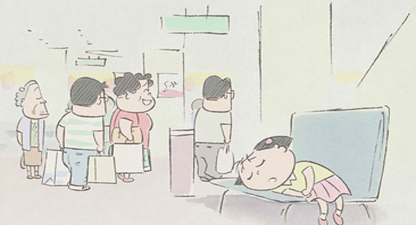
The first thing that bothered me was a fairly minor complaint— the poor lip-synching in the early scenes, at least in the English dub (but not much better with the Japanese track either). This can always be a challenge when dubbing a movie, and I felt they fell short here. Action films are more forgiving, but in a movie propelled by dialog, it just kills it. It’s too bad, since the early part of the film seemed the most promising, with existential musings giving way to metaphorical fantasy. This was by far my favorite part of the film. It seemed initially that this would be a pleasant mixture of Peanuts, For Better Or For Worse, and maybe Calvin And Hobbes. After that, the film regrettably becomes more mundane, but the dubbing seemed to get better, even as I switched back and forth from the English to Japanese tracks.
The visual style remains mostly consistent, though. The drawings appear almost unbearably crude. They are also scratchy, with outlines not staying consistent from frame to frame. Obviously, a “comic strip comes to life” approach was chosen. (The only real departure from the main style is with a motorcycle gang sequence that stays scratchy but is much more realistic.) The backgrounds either don’t exist, or are bare suggestions. This would look charming in a short, but again I felt it did not suit the feature format, especially given the color pallet that was chosen— pale pastels in a watercolor style. The unfortunate characters look like they are fading away and dissolving into squiggly ether. Well, I may be exaggerating, but to me the visual style was another drawback for a film that already had a weak script.

A note about that animation style, though: Although no mention is made of it in the special features, this was a fully digital movie, with no hand-painted cels being used. There are a couple of instances of 3-D modeling, but mostly the film keeps a flat appearance. The use of simple drawings, sparse backgrounds, and weak computer-painted colors was an interesting experiment, even if I did not care for the results. Likely, I would have appreciated it more if I liked the character design better. While much better drawn than their comic strip counterparts (sorry, but the examples I have seen on the Net from Tonari No Yamada-kun look terribly amateurish), the designs of the Yamadas in the film still are not all that appealing. Perhaps a larger departure from the look of the strip would have been in order.
So, about that script… Perhaps something was lost in translation. It can be difficult to export comedy from one culture to another. Several times, I would watch a scene with the English dub, and be uncertain of what was supposed to be funny. So, I would re-watch it with the closed captioning (which sports a more literal translation of the original Japanese), and I would be even more dumbfounded. I have heard that Seinfeld and other American sitcoms have had trouble recreating their domestic success in international markets due to the inherent American-ness of the comedy, and it looks like the same (but reverse) is true here. Turns of phrase and plays on words that are undoubtedly humorous in Japanese simply mean little in English. The remaining humor, to be gleaned from events rather than dialog, is simply not wild enough in this movie to make much of an impression. The directing is rather flat as well, with actions that could have been broader, and timing that could have been sharper.
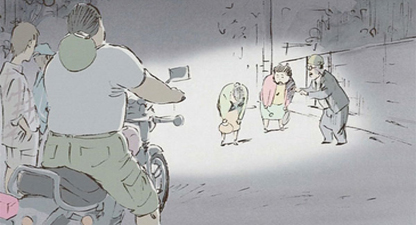
I did laugh out loud once, but that may have just been out of pity. Well, no— actually, I still find that scene funny looking back on it now. Shige musingly wonders aloud at how many more springtimes she will see, and Matsuko (her daughter) reassures her that she has many years ahead of her. Shige then does the math, and calculates that she could indeed be around (and therefore still living with the Yamadas) for another thirty years. Matsuko appears to have a seizure, freezing for several seconds before dropping to the ground… Sorry, I just spoiled the best joke in the film. The rest is an endless succession of not-so-funny scenes, something like watching someone’s home movies. Well, the fighting-for-the-remote scene was funny too; “remote war” transcends cultural differences, I suppose.
In all, this was a noble try, but it fell rather flat for me. I appreciate the effort to try something different, but I wish Studio Ghibli better luck in the future. I would still encourage true fans of animation to at least give this a rental, though, since the design is unique and your sense of humor may be different than mine. For me, however, this film sits far behind other Ghibli films in terms of entertainment quality.
(Thanks to nausicaa.net for some of the information used in this review.)
Is This Thing Loaded?
This is Disney’s first Ghibli disc since Princess Mononoke to come with only one disc, but considering that most of those second discs only had storyboards on them anyway, it isn’t too much of a loss here. We still do get the Original Japanese Storyboards for the film, but instead of running like a movie as on the earlier sets, here they are presented as blocks of still images, divided up by scene. Once you get to the end of a storyboard you have the option of viewing the final scene.

Additionally, we get another of those Behind The Microphone pieces (5:31), but as usual we only meet the English-language performers. It’s okay for what it is, and all the actors naturally show more enthusiasm for the film than I am able to muster. The final extra consists of a series of Trailers (16:08). The first trailer is really pretty neat, since it shows incomplete animation; what is unique about this is that the incomplete work looks more finished in some ways than the finished product, since the “scratchiness” has not been added in yet. Some of the trailers promise a “story filled with laughter, tears, and emotions”. I wish they were right.
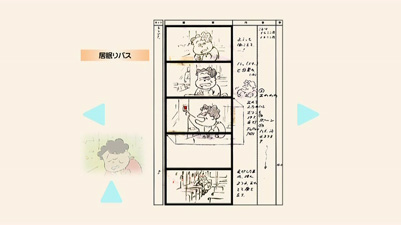
Case Study:
Standard keepcase in an identical slipsleeve.
Ink And Paint:
While I did not care for the visual style, I cannot fault the transfer. The 16:9 anamorphic image is done just right, even if the nature of the style used in the movie gives the impression of shimmering at times, due to changing outlines on moving characters and backgrounds. Everything else looks perfect— no halos, no macro-blocking, or anything else to distract the eye. This may have even been a digital-to-digital transfer, given how the film was created. Regardless, I do not imagine that compressing the simple images in this movie was too problematic, especially considering they used two layers on this disc.
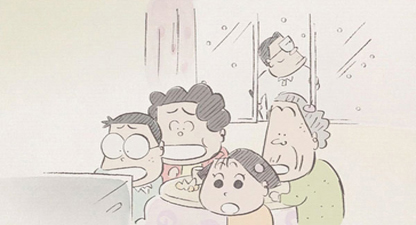
Scratch Tracks:
While one would not expect a 5.1 mix to mean too much in a film of this type, the mix on this family “dramedy” does impress. Most of the audio effects come from the music, with various parts of the orchestra making appearances in various speakers. A few other examples of skillful sound mixing exist as well, such as when the family chases Noboru on a giant snail, or when fireworks sound off. Both the Japanese and English 5.1 tracks are the same in this regard.
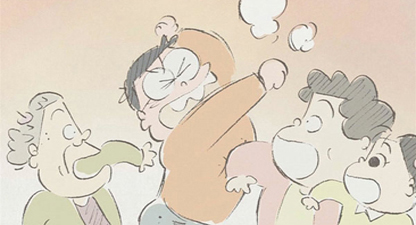
Aside from David Ogden Stiers’ narration, the English cast includes Jim Belushi and Molly Shannon as the parents, and the reliable Tress MacNeille as Shige. Daryl Sabara (Spy Kids) and Liliana Mumy (Billy’s daughter) play the kids. There are good efforts from all in a losing cause.
There are three subtitle tracks, all in English. There is of course a subtitle track for the English spoken dialog. There is also a closed captioning track that I suspect gives a truer translation of the original Japanese, since the captions are often very different than the English spoken dialog, and seem non-Americanized. A third track only provides translations for written Japanese on-screen (this defaults along with the English language audio).
Final Cut:
I found this to be a disappointing film from Ghibli, offering more promise than actual laughs. Perhaps I am just not “plugged in” enough to the film’s sensibility. There seems to be a charming little movie trying to show itself, but in the end it is stifled by the mundane. Nevertheless, some may conceivably love what they see. The film’s presentation on DVD is optimal, even if there is little production history or information to be found in the Extras section. File this under “rent it if curious”.
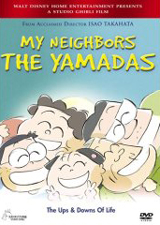 | ||
 |










